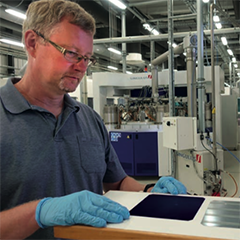New opportunities for integrated solar electricity
New PV technologies make it possible to create more diversity to the utilization of solar energy. High efficiency, low cost and good looks of PV applications make it feasible to integrate solar power to new products and environments.
Any self-powering object creates a local energy source. Solar energy can be used in many building integrated PV (BIPV) applications, such as facades, window structures or balconies. All vehicles are potential producers of solar energy. In principle, any energy-requiring object under the sun could produce PV power. Integrating PV can bring new value-adding features to products or even create completely new products. Producing local off-the-grid power will be the future. Now, is the time to redefine solar technology and make it a natural part of the environment.
Valoe´s integrated solar technology meets new challenges
There are no off-the-shelf products for integrated PV applications. The traditional cell and module designs cannot meet the various demands that the integrated PV will face. If PV is integrated into vehicles (VIPV), they need to survive vibration and to be shock and wear resistant. The weight of the module needs to be as light as possible and the PV element must be flexible and adjust to the surface form.
Survivability, in case of damage, is a very essential demand. If one part of the module gets broken, the rest of it must remain functional. Visual appearance becomes more and more important if the solar module is placed in urban space. Not to mention the building applications where architects make the visual look the most significant feature.
A traditional PV module is optimized for mass production and stationary installations. To meet the different requirements of integrated products, totally new PV technology is needed. Every application has its own demands where the cell and module design must be adapted. However, one feature is common: the highest possible efficiency of electricity generation is required.
Valoe is in the process of developing a technology platform for VIPV and BIPV applications. We will soon see self-charging cars, buildings generating their own electricity, evening lighting produced by daily sunlight. These and many other fantastic ideas may soon come true! However, they still require leaps of various length and close cooperation with multinational teams in PV product development:
New opportunities for integrated solar electricity
New PV technologies make it possible to create more diversity to the utilization of solar energy. High efficiency, low cost and good looks of PV applications make it feasible to integrate solar power to new products and environments.
Any self-powering object creates a local energy source. Solar energy can be used in many building integrated PV (BIPV) applications, such as facades, window structures or balconies. All vehicles are potential producers of solar energy. In principle, any energy-requiring object under the sun could produce PV power. Integrating PV can bring new value-adding features to products or even create completely new products. Producing local off-the-grid power will be the future. Now, is the time to redefine solar technology and make it a natural part of the environment.
Valoe´s integrated solar technology meets new challenges
There are no off-the-shelf products for integrated PV applications. The traditional cell and module designs cannot meet the various demands that the integrated PV will face. If PV is integrated into vehicles (VIPV), they need to survive vibration and to be shock and wear resistant. The weight of the module needs to be as light as possible and the PV element must be flexible and adjust to the surface form.
Survivability, in case of damage, is a very essential demand. If one part of the module gets broken, the rest of it must remain functional. Visual appearance becomes more and more important if the solar module is placed in urban space. Not to mention the building applications where architects make the visual look the most significant feature.
A traditional PV module is optimized for mass production and stationary installations. To meet the different requirements of integrated products, totally new PV technology is needed. Every application has its own demands where the cell and module design must be adapted. However, one feature is common: the highest possible efficiency of electricity generation is required.
Valoe is in the process of developing a technology platform for VIPV and BIPV applications. We will soon see self-charging cars, buildings generating their own electricity, evening lighting produced by daily sunlight. These and many other fantastic ideas may soon come true! However, they still require leaps of various length and close cooperation with multinational teams in PV product development:
To read the full content,
please download the PDF below.


























